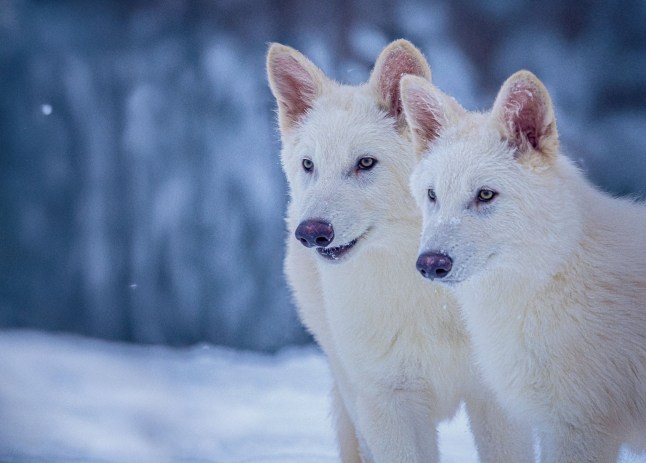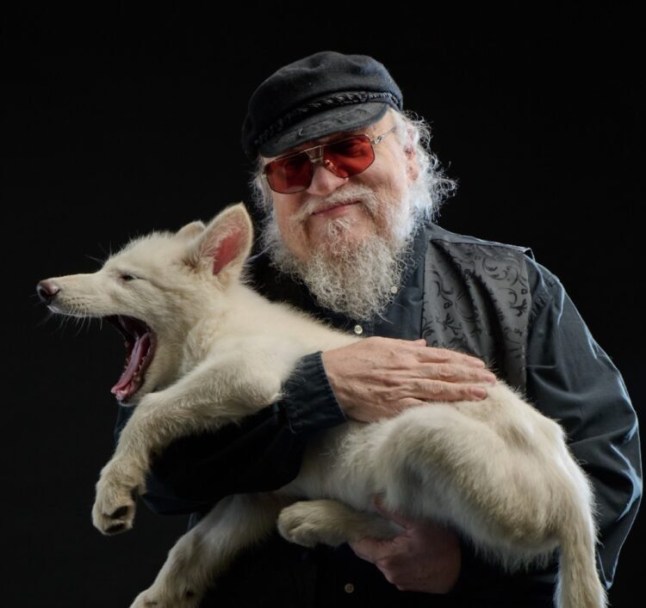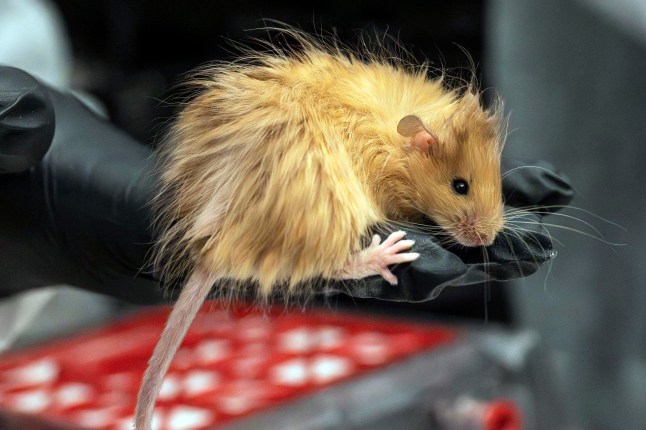
A huge wolf lost for 10,000 years really has been brought back from the dead and will be roaming in a pack by the end of this year, scientists claim.
The founder of Colossal Biosciences, Ben Lamm, told Metro that high profile criticism of their work boiled down to philosophy rather than the science behind it.
The company, which also plans to bring back the dodo and woolly mammoth, announced this week that three white ‘dire wolf’ puppies have been born, making the creature the first ever to become ‘de-extinct’.
This was immediately hit by a wave of denials by some scientists who claim it is more accurate to call them genetically modified grey wolves.
But Lamm said scientists don’t agree on when a new species begins, so he won’t stop calling them dire wolves – or mammoths, if he gets that far – unless they do.
You may not have realised dire wolves were ever real, as they are best known recently as loyal companions and protectors of the Stark children in Game of Thrones.
But the wolves, which were bigger and shaggier than the ones that made it to 2025, really are part of the fossil record, after dying out around the end of the last Ice Age.
Game of Thrones brought to life
The first pups Remulus and Remus were born in October last year, while their younger sibling Khaleesi, named after the ‘Mother of Dragons’ in the series, was born in January.
The author of A Song of Ice and Fire is certainly convinced. George R. R. Martin posted about visiting Ben Lamm, George Church, Beth Shapiro, ‘and the rest of their team of mad scientists’ in February.
Writing on his blog yesterday, he described visiting the reserve in north America where they live, but would not reveal its location.
He even arranged for the pups to sit on the actual Iron Throne used in the TV show, where they curled up for a peaceful nap.

There are more to come
Lamm told Metro he expects to have enough ‘dire wolves’ to make a full pack by the end of this year.
He said: ‘For the short term, we’ll probably make another three to five.
‘So we’ll probably have a pack of somewhere from six to eight. We think that’s the right pack dynamic: It’s right down the fairway in terms of what lot of wolf packs end up being.’
The eldest two pups are now around 80lb (36kg). At full size, they are expected to be around 140lb (63kg), which is 40lb (18kg) heavier than a normal wolf.
Lamm said he’s met them and even bottle fed them – though he won’t get as close to these particular pups again, as they’re getting too large and wild.

They will keep living there as the pack grows, while scientists study their social dynamics and their their health to make sure ‘everything is going well from an animal welfare perspective’.
After this, they are looking at ‘potentially rewilding them’ on indigenous land in the US, given the cultural connection to the dire wolf for some Native American groups.
‘At that point, maybe we’ll maket more and more, but that’s that’s where we’re starting,’ Ben said.
Are they really dire wolves?
People are getting too hung up on this semantic question and it is becoming a waste of time, the entrepreneur claimed.
Are they an exact clone of the dire wolves which once roamed Earth? No, they’re not: the company targeted 20 genes to modify in a grey wolf genome, which code for traits that are crucial to dire wolves.
That means it is functionally similar, but has many other genes which are still grey wolf genes. So is it a dire wolf 2.0, a hybrid, or just a ‘designer’ grey wolf? It depends on who you ask.
Corey Bradshaw, a professor of global ecology at Flinders University in Australia, said the technology to modify entire genomes does not exist: ‘They have slightly genetically modified wolves, maybe. And that’s probably the best that you’re going to get.’
But the Colossal CEO said: ‘If we can get the scientific community to agree on speciation – which they can’t – we may call our animals something different.’
Looking at their plans to bring back woolly mammoths, he said if they engineer an elephant to become a mammoth as they plan to, it will be obvious: ‘We know what mammoths looked like because we have pulled them from the permafrost and we can see them.’
Visitors to fictional Jurassic Park wouldn’t have had to wonder too hard about the exact genetic make-up of what they saw, he added.
‘Did they make dinosaurs, or did they make genetically modifed organisms using DNA? What makes a dinosaur a dinosaur?’
Hitting back at further claims they had not published enough on the science behind the dire wolf pups, he said: ‘So why doesn’t Pfizer do that when they make a drug? We’re a private company, we’re not an academic lab. We raised half a billion dollars to build technologies.’
How did Colossal ‘de-extinct’ the dire wolf?

The DNA which survived so many thousands of years is not intact enough to just make a clone, so researchers had to piece together their genome and then reverse engineer key traits in a modern wolf.
To analyse the DNA, they used a fossilised 13,000-year-old tooth, and a 72,000-year-old skull.
They compared it to the genomes of similar animals, including wolves, jackals and foxes, to pinpoint genes specific to dire wolves and recreate them.
The grey wolf is the dire wolf’s closest living relative, so it was used as the base to recreate its taller, stockier and paler cousin.
Colossal claim to have made 20 edits to genes, including 15 edits from ancient gene variants ‘that have not existed in over 12,000 years’.
They said this is the ‘largest number of precise genomic edits in a healthy vertebrate so far’ and the capability is ‘growing exponentially’.
Genes targeted for editing affected fur, whisker length, ear shape, vocalisations, more powerful shoulders, a wider head, larger jaws and teeth, and thicker, more muscular legs.
Modified DNA was inserted into denucleated grey wolf egg cells, which matured in a lab before they were placed into wombs of surrogate dogs to gestate.
Where are these wolves living now?
If you’re worried about encountering them on a hike, fear not. Although their exact location has not been revealed, Colossal say they are securely housed on a 2,000 acre site behind a 10ft fence, and continuously monitored with on-site cameras.
Although they have the potential to breed, they won’t be doing this; at least not in the short term.
‘We will manage that through subdermal contraception and separation by tracking estrous cycles,’ Lamm said.
What is the point of this?
The topic of rewilding and the reintroduction of species is controversial, particularly when it comes to something like wolves, because… well, you’ve read Little Red Riding Hood.
A less fraught topic is conservation of existing species. It is often said that we are living through the ‘sixth mass extinction’ due to human activity.
Colossal say that its work can help save species, both by bringing them back once lost, and by protecting them before this happens.

As well as announcing the birth of ‘dire wolves’, Colossal also said it has taken a big step in protecting critically endangered red wolves.
It managed to clone four pups from different bloodlines using a less invasive technqiue, which is hoped will make it possible to introduce genetic diversity to the decimated wild popultion.
Red wolf puppies Hope, Blaze, Cinder, and Ash may not have grabbed headlines in the same way, but could have a bigger impact on global conservation in future.
If you’re holding out for the mammoth, though, you’ll have to be content with the ‘woolly mouse’ they made for now.
Get in touch with our news team by emailing us at webnews@metro.co.uk.
For more stories like this, check our news page.
MORE: ‘Cruel and distressing’ animal conditions exposed at China’s oldest zoo
MORE: ‘Miracle’ baby born after mum had first ever womb transplant in the UK
MORE: Mysterious 410ft Great Blue Hole in Belize hides a ‘concerning’ secret












